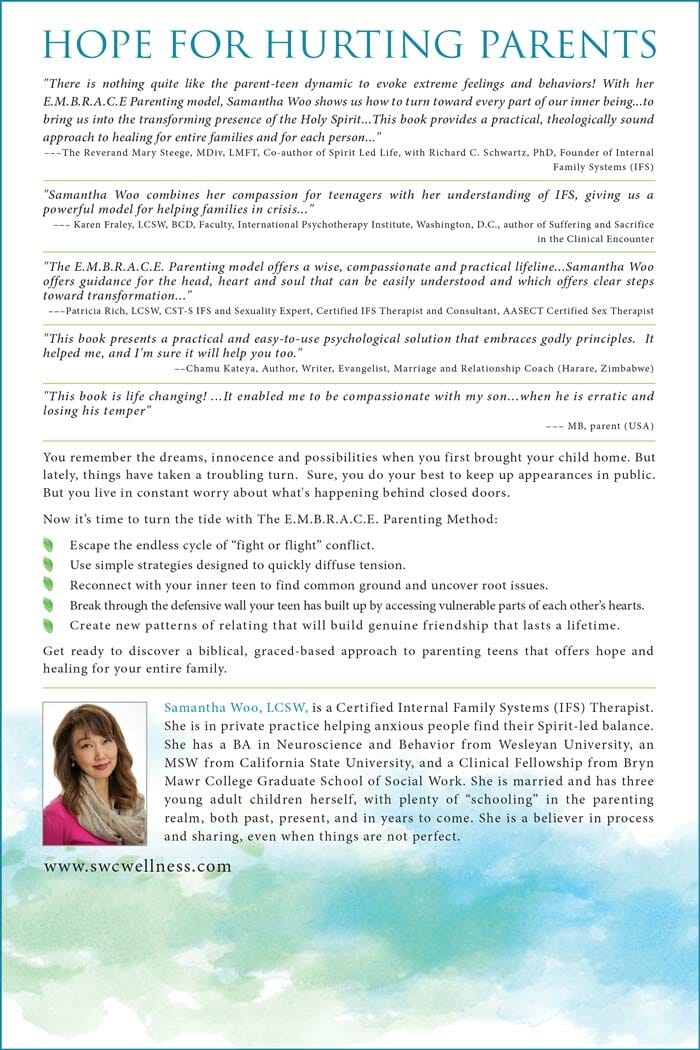How to Stop Yelling & Start Connecting with Your Highly-Emotional Teen: Healing Anxiety, Depression & Trauma Using The E.M.B.R.A.C.E. Parenting™ Method is the new book from Samantha S. Woo. It is a must-have guide for parents who are having difficulties with their teens.
Being the parent of a teen is not easy. Often, this involves conflicts that happen nearly every day, fights over small things, tension, and worry. Teens might appear emotionally volatile, always changing their moods, reacting, and overreacting. This makes the work of a parent hard, especially when many parents remember how easy or at least easier things were before. One can worry a lot about what goes on inside a teen’s head behind their closed bedroom doors. Samantha S. Woo offers an effective method for dealing with these issues and defusing tension in the home. It focuses on the work the parent can do with simple and practical strategies.
E.M.B.R.A.C.E. Parenting Method involves a way to end the endless conflict and break the vicious cycle of fights that can feel entrenched and inescapable. It is meant to quickly diffuse tension and build a strong relationship, reconnecting with the teen. For the parent, it offers a way of reconnecting with their inner teen as well to help reach this new and hostile adolescent living in their home. This builds trust and confidence.
How to Stop Yelling & Start Connecting with Your Highly-Emotional Teen: Healing Anxiety, Depression & Trauma Using The E.M.B.R.A.C.E. Parenting™ Method is a guidebook that is sure to serve any parent with a teenager. It provides solutions for reaching your teen and accessing their heart, building a friendship that will last forever. In addition, the book offers a biblical approach that is centered on providing hope and healing. The book can be found on Amazon below:
The book is a must-have guide because of the compassionate, biblical way in which it frames the problem, so for any Christian families, it is sure to serve as an effective method of reaching the goal of a strong relationship with your teen child, even when they are dealing with a lot of mixed emotions and difficulties.
The book has a healing, serene voice that is perfect for parents who feel exhausted or lost or who are not sure what they need to be doing. It creates small, actionable steps that any family can take to improve the situation they are facing. This will make great reading for parents with kids entering puberty or who are already at this stage. It is sure to offer a lot of comfort, hope, and peace to any parent facing a difficult situation.
The E.M.B.R.A.C.E. method is strong and easy to read. It is based on the idea of the whole person, which makes it apt for a variety of situations and families. It will serve as a great source of support to parents and families.
We had the pleasure of interviewing Samantha. Here are the excerpts from the interview.
Hi Samantha, Great to have you with us today! Please share with our readers about yourself.
Hi, I’m a Certified Internal Family Systems Therapist. I am in private practice helping people find peace and balance using this model of therapy, which I find to be quite miraculous and effective. I like to see things from a big-picture perspective, so I often weave various perspectives and come to an intersection of what people may commonly see as different. But these are, at the essence, more connected than how it appears. Personally, I am a mother of 3 young adult children myself, and a wife to someone who is in a high-stress profession.
Please tell us about your book.
This book is called “How to Stop Yelling & Start Connecting with Your Highly Emotional Teen: Healing Anxiety, Depression, & Trauma with The E.M.B.R.A.C.E. Parenting™ Method.” It is a 7-step book, with each section of a step infused with personal stories of a family, clinical sections with a therapist, biblical reference, and personal application. It follows a healing path of a fictional family that was obviously a conglomerate of many cases I saw both inside and outside the therapy space. And it is also a symbolic family– external representation of the parts of us inside– our “internal family” inside our personality. The seven steps that I introduce: E.M.B.R.A.C.E. Parenting is a layperson’s version I came up with for the Internal Family Systems model created by Dr. Richard C. Schwartz, Ph.D. And each chapter or step is divided into sections where there is a short introduction, then an in-session where we follow a particular family in therapy, then an explanation, then an application.
The story of this family is so common. A teen that has become depressed all of a sudden, it seems. And isn’t able to get up in time for school but is glued to video games and is in conflict with their parents. Some parents overmanage and make it worse by yelling, and other times they give up, and neglect them. And we see too often this age as a “don’t touch” type of stage where people don’t want to deal with sensitive or emotional teenagers much. I certainly didn’t.
The crisis of care is so dire. I mean we look at the mass shootings, and many of them are done by late teens, certainly still in this ‘adolescent developmental years’ until their brains are fully formed in their late 20’s. Many people cannot get into therapy because of waitlists or qualified therapists. And even for this therapy training, one has to enter a lottery, and some therapists wait years to get into just level 1 training. Once you get into a training, there is a lack of therapists of color who may be in touch with the subcultures of BIPOC folk, who many times struggle to get into therapy because they rely on the religious/spiritual communities that may still have stigma. These communities still sometimes have negative views of therapy. I was fortunate enough during the pandemic to have these I.F.S. trainings back to back and get enough experience to get certified. So it’s my way of doing my part to share what I was able to receive in a more accessible way for the layman person. Even if it is just one thing, they get out of the book.
Please tell us about your journey.
Well, when I was working in a behavioral hospital outpatient department, I had a few young men who were around 18-19 who were quite depressed and traumatized. Talk about a parallel process. This was also when I had my own teenagers. And colleagues and friends who also did as well. Needless to say, it was a wealth of clinical and personal learning there. I saw what approaches worked and didn’t work at work and home. Coming down hard or using challenge modalities or things from a “managerial” or coaching energy certainly almost always backfired for these sensitive clients who had trauma. These sensitive, tender ones responded much better to this approach of I.F.S.
What are the strategies that helped you become successful in your journey?
The best strategy was truly to EMBRACE various parts of myself and the teen. Openness to trying something different. Moving into the discomfort of being with someone who, on the surface, was described as “difficult.” Trusting they had a core inside that was different from the parts of them that were acting difficult. Moving away from judgement, befriending, relating, accessing the real pain underneath, creating something different and new, and letting them engage long-term. I tried the C.B.T., D.B.T., and psychoanalytic, but the most effective and surprising thing was this concept of core Compassion of Internal Family Systems, which had sowed so much more transformation. This really was in great alignment with my personal faith, so it felt natural and organic. I saw clients whose parents insisted who could not stay with a therapist, stick with me for years and transform. And I saw someone who was recovering from opioid addiction go from bottoming out to getting a job and becoming a supervisor, all from this method.
Openness to learning both from colleagues and clients, not going in with preconceived notions but like a dance seeing the flow of steps but going with the music, so to speak.
Any message for our readers.
Parenting is something we take for granted as a society, and have lost the art of doing it with heart. A lot of head knowledge out there, but if we can engage our heart and soul. By healing our own hearts, it would open up so much more hope and freedom in the journey. And really give the gift of hope to ourselves and the next generation, and generations to come.
Fantastic! So tell us, how can people find out more about you?
You can visit the website or follow on Facebook @SWCounselingandWellness and Instagram @sw_counseling_wellness.
Thank you so much, Samantha, for giving us your precious time! We wish you all the best for your journey ahead!
Get your story featured on Betterauds.com! We accept paid submissions for guest posts and stories, You can submit your article here.


